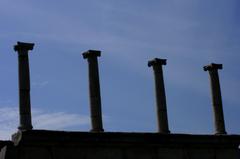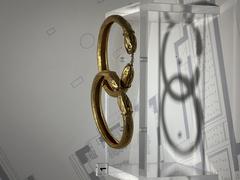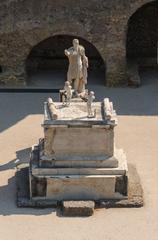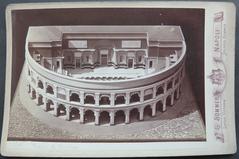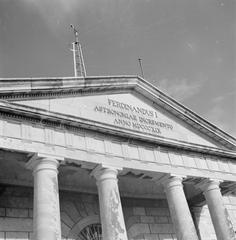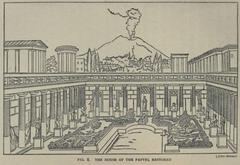Painted Papyrus at Herculaneum: Visiting Hours, Tickets, and Historical Significance
Date: 03/07/2025
Introduction
Nestled on the scenic Bay of Naples, the ancient town of Herculaneum stands as a remarkable testament to Roman luxury, resilience, and intellectual achievement. Preserved by the catastrophic eruption of Mount Vesuvius in 79 CE, Herculaneum offers a uniquely intimate glimpse into daily life, architecture, and thought in the Roman world. Unlike its more famous neighbor Pompeii, Herculaneum was buried under a thick layer of pyroclastic material, which preserved not only its buildings and art but also delicate organic materials—most notably, the extraordinary carbonized papyrus scrolls known as the Herculaneum Papyri or “Painted Papyrus” (NaplesWise; Artnet News).
Housed within the opulent Villa of the Papyri, these scrolls represent the only surviving ancient Greco-Roman library found in situ. The Villa, likely owned by Lucius Calpurnius Piso Caesoninus, Julius Caesar’s father-in-law, was a center of art, philosophy, and culture (Ercolano Cultura; Herculaneum Tour Guide). Today, ongoing excavations and cutting-edge scientific research—such as non-invasive imaging and artificial intelligence—continue to unlock the secrets of these ancient texts, offering new insights into Epicurean philosophy and Roman intellectual life (Scientific American; Greek Reporter).
This guide provides everything you need to plan your visit to Herculaneum and the Villa of the Papyri: historical background, ticketing and accessibility tips, the latest scientific breakthroughs, and practical visitor information.
Table of Contents
- Historical Background and Archaeological Discovery
- Planning Your Visit
- The Villa of the Papyri: Visitor Guide
- Scientific Breakthroughs: The Herculaneum Scrolls
- Visitor Experience and Practical Tips
- Frequently Asked Questions
- Conclusion and Call to Action
- References
Historical Background and Archaeological Discovery
Origins and Early History of Herculaneum
Founded likely by the Oscans in the 6th or 7th century BCE and later influenced by Greek, Etruscan, Samnite, and ultimately Roman control, Herculaneum developed into a wealthy seaside resort by the 1st century CE. Its elite residents enjoyed lavish villas, public baths, and a vibrant cultural scene (NaplesWise; Nomad Epicureans).
The Eruption of Mount Vesuvius
The eruption in 79 CE buried Herculaneum under up to 27 meters of pyroclastic flows. These surges carbonized organic materials and instantly preserved homes, furniture, textiles, and scrolls (Artnet News; Archaeology Magazine).
Rediscovery and Early Excavations
Herculaneum was rediscovered in 1709. Systematic excavations began under Charles III of Spain, and between 1750 and 1765, the Villa of the Papyri was unearthed, revealing its remarkable library of nearly 1,800 papyrus scrolls (News360; Photonicsonline).
The Painted Papyrus and the Herculaneum Papyri
These carbonized scrolls—often mistaken for charcoal at first—are the only ancient Greco-Roman library found intact. Early efforts to unroll them caused much damage, but surviving fragments have allowed scholars to identify works from Philodemus and other Greek philosophers (Facts and Details).
Advances in Archaeological Methods and Conservation
Modern, non-invasive imaging techniques such as infrared, X-ray tomography, and synchrotron radiation now allow researchers to virtually “unwrap” the scrolls without physical damage, revealing texts previously thought lost (Smithsonian Magazine).
The Vesuvius Challenge and the Role of Artificial Intelligence
The Vesuvius Challenge, launched in 2023, harnessed AI and high-resolution 3D X-ray scans to accelerate scroll decipherment. In 2024, a team successfully read over 2,000 Greek characters from a previously unreadable scroll (Italian Insider; Oxford News; Archaeology Magazine). These technological breakthroughs are now being considered for use on other ancient manuscripts.
The Villa of the Papyri: Archaeological and Cultural Significance
The Villa of the Papyri, modeled by the modern Getty Villa in California, remains one of the most significant archaeological sites of the Roman world. While much of the villa is still being excavated and is not always open to the public, its artifacts—statues, mosaics, and many papyri—can be seen in the Naples National Archaeological Museum (NaplesWise).
Ongoing Excavations and Conservation Efforts
Only about one-third of Herculaneum has been excavated to date. The Herculaneum Conservation Project, started in 2001, continues to stabilize and preserve the site, ensuring its survival for future generations (World History Encyclopedia).
Planning Your Visit to Herculaneum
Herculaneum Visiting Hours
The site is open daily except Tuesdays, typically from 9:00 AM to 7:30 PM, with last admission 30 minutes before closing. Hours may vary with seasons or special events. Check the official site for up-to-date information.
Herculaneum Tickets and Prices
Tickets cost approximately €13–€15 for adults, with discounts for EU citizens (ages 18–25), students, and free entry for children under 18. Combined tickets with other sites (e.g., Pompeii) are also available. Book online in advance to avoid queues (Visit Italy).
Accessibility and Facilities
Herculaneum offers accessible routes and assistance for visitors with mobility needs, though some ancient streets and buildings can pose challenges. Facilities include restrooms, a shop, and multilingual signage. There are no cafes on-site, but plenty can be found nearby.
Guided Tours and Special Events
Guided tours, often led by archaeologists, are available and highly recommended. Special events—such as workshops and evening tours—are sometimes offered. Check official websites for details.
Nearby Attractions and Travel Tips
Herculaneum is conveniently located for visits to Pompeii, Mount Vesuvius, and the Naples National Archaeological Museum. Use the Circumvesuviana train from Naples or Sorrento; the Ercolano Scavi station is a 10-minute walk away.
Villa of the Papyri Visiting Hours, Tickets, and Visitor Guide | Ercolano Historical Sites
Historical Background of the Villa of the Papyri
The Villa of the Papyri was a luxurious Roman residence built in the 1st century BCE, believed to have belonged to Lucius Calpurnius Piso Caesoninus (Wikipedia; Herculaneum Tour Guide). Buried by Vesuvius, it preserved architecture, sculpture, and the unique papyrus library (Ercolano Cultura).
Art, Architecture, and Decorative Features
The villa contained over 90 sculptures and extensive gardens. Its architecture inspired the Getty Villa in Los Angeles. Many original artifacts are housed at the Naples National Archaeological Museum (Pompeii with Archaeologist).
Visiting the Villa of the Papyri: Hours, Tickets & Tours
- Access: Located within the Herculaneum Archaeological Park, about 10 km from Naples.
- Hours: Park is open daily (except major holidays) with seasonal variations; typically 8:30 AM–7:30 PM in summer, 8:30 AM–5:00 PM in winter (Italy Heaven).
- Tickets: €11–€15, available online or at the entrance; discounts apply (Spacial Anomaly).
- Guided Tours: Available and recommended, especially for understanding the villa’s history (Pompeii with Archaeologist).
- Accessibility: Some areas are accessible, though uneven terrain may present challenges.
Herculaneum Scrolls: Visiting Hours, Ticket Info, and the Latest Scientific Breakthroughs
The Scrolls’ Preservation and Decipherment
The Herculaneum scrolls, carbonized by volcanic heat, presented a formidable challenge to scholars. Recent advances—X-ray micro-CT scanning and AI-driven digital ink detection—have allowed researchers to virtually unroll and read scrolls without physical damage (CBS News; CNN).
The Vesuvius Challenge, an international effort, has already yielded partial decipherment of texts—most notably, works by Philodemus, a leading Epicurean philosopher (Greek Reporter). AI models now help distinguish ink from papyrus, even when both are carbon-based (Scientific American).
Where to See the Scrolls
Most original scrolls are conserved at the National Library of Naples and the Bodleian Libraries at Oxford. Visitors can explore digital reconstructions and high-resolution images at the archaeological park and at the Naples National Archaeological Museum.
Visitor Experience and Practical Information
Site Layout and Accessibility
Herculaneum is compact and easy to navigate; paved paths and ramps help with accessibility, but some uneven surfaces persist (Italy Heaven). Always check for temporary closures due to restoration.
Tickets and Entry
Purchase tickets online, especially in peak season. Audio guides and guided tours are available for a more informative visit (Visit Italy).
Tips for Visitors
- Wear comfortable shoes and bring sun protection.
- Arrive early for fewer crowds and cooler weather.
- Photography is allowed, but flash and tripods may be restricted.
- Plan to visit the Naples National Archaeological Museum for a complete experience.
Frequently Asked Questions (FAQ)
Q: What are the Herculaneum and Villa of the Papyri visiting hours?
A: The park is usually open 8:30 AM–7:30 PM (April–September), 8:30 AM–5:00 PM (November–March). Check the official site for updates.
Q: How do I buy tickets?
A: Buy online for convenience and to avoid queues, or at the entrance.
Q: Is the site accessible?
A: Many areas are accessible, but some uneven terrain may limit access.
Q: Are guided tours available?
A: Yes, guided tours by experts are widely available and recommended.
Q: Can I see the original scrolls?
A: Most are housed in Naples or Oxford, but digital and physical exhibits are on view at the museum and archaeological park.
Conclusion and Call to Action
Herculaneum, with the Villa of the Papyri and its Painted Papyrus scrolls, offers a unique and immersive journey into the ancient Roman world. The exceptional preservation, groundbreaking scientific advances, and accessible site make it a destination for history enthusiasts, scholars, and travelers alike. For the latest updates, audio guides, and insider tips, download the Audiala app and follow us on social media.
Start planning your journey to one of Italy’s most remarkable archaeological treasures—experience the art, philosophy, and daily life of ancient Herculaneum for yourself!
References and official links for Painted Papyrus at Herculaneum
- Visiting Herculaneum: Hours, Tickets, History, and Travel Tips for Naples’ Ancient Gem, 2025, NaplesWise (https://napleswise.com/herculaneum/how-to-visit-herculaneum-our-complete-guide/)
- Visiting the Villa of the Papyri: Tickets, Hours, History & Highlights at Herculaneum’s Historic Site, 2025, Herculaneum Tour Guide (https://herculaneumtourguide.com/the-villa-of-papyri/)
- Herculaneum Scrolls: Visiting Hours, Ticket Info, and the Latest Scientific Breakthroughs, 2025, Greek Reporter (https://greekreporter.com/2025/05/06/lost-work-greek-philosopher-philodemus-unearthed-herculaneum-scroll/)
- Villa of the Papyri Visiting Hours, Tickets, and Visitor Guide | Ercolano Historical Sites, 2025, Visit Italy (https://www.visititaly.eu/tickets/herculaneum-archeological-park)
- Inside the AI Competition That Decoded an Ancient Scroll and Changed Everything, 2025, Scientific American (https://www.scientificamerican.com/article/inside-the-ai-competition-that-decoded-an-ancient-scroll-and-changed/)
- The Hunt for Herculaneum Papyri, 2025, Artnet News (https://news.artnet.com/art-world/the-hunt-herculaneum-papyri-2451636)
- Deciphering the Past: The Herculaneum Papyri and the IA Project Vesuvius Challenge, 2025, News360 (https://www.news360.es/usa/2025/02/26/deciphering-the-past-the-herculaneum-papyri-and-the-ia-project-vesuvius-challenge/)
- Reading Herculaneum Papyri Without Unrolling Them, 2025, Smithsonian Magazine (https://www.smithsonianmag.com/history/reading-herculaneum-papyri-without-unrolling-them-180955697/)
